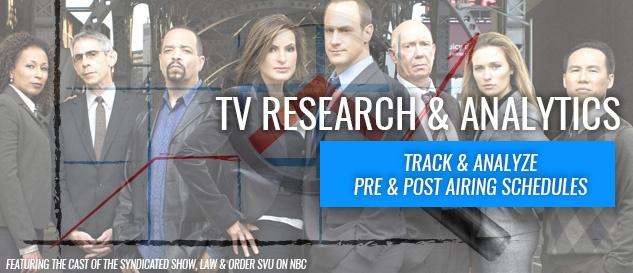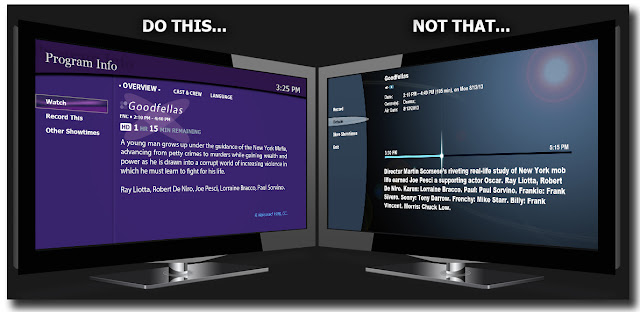Movies, unlike TV shows, don’t have episodes. They don’t
have a specific time slot they appear in every day or week. So they can’t
necessarily rely upon a returning captive audience that knows all the
parameters of their offering.
As such, the description of a movie in an EPG (Electronic
Program Guide) must inform the potential viewer fully—without divulging any
information that would diminish the viewer’s enjoyment of discovering the film
on their own.
So, a movie description in a TV listing should DESCRIBE, and
not DIVULGE.
There are a number of editorial standards that make a good
description. As usual, we’ve listed them here for you.
1. That’s a description,
not a kitchen sink.
We’ll begin by defining a description to be an accurate reflection of a film’s content regardless of extraneous info like the director, the year it came out, who stars in it, or how many awards it won.
We’ll begin by defining a description to be an accurate reflection of a film’s content regardless of extraneous info like the director, the year it came out, who stars in it, or how many awards it won.
With this editorial standard, viewers can assess a film
without considering all those other factors—which are still available to be
evaluated OUTSIDE the description. Added on as another layer of important
information, but without “tainting” the description itself.
Good descriptions, as seen in our example, confine
themselves to describing just the film in an objective, positive manner. (Just click on the images view them in a larger size.)
The bad example? Well, they’ve “kitchen sinked” it. Thrown everything in there
and expected you to sift through it.
Just look at it. It’s got actor’s names, a smattering of
plot, a biased review, a non-sequitur actor’s name, and a spoiler that
references a dubiously memorable scene.
So, in the bad example, the film’s story doesn’t get just
due, and other elements are similarly watered down and mixed together so a
viewer doesn’t really know what to grasp.
Remember, a description is just that. A description. Not a
list of credits or a resume or anything else. Even in a bizarre hodgepodge.
Therefore, a description shouldn’t read like a ransom note
with every random bit of info thrown in like jumbalaya.
2. The movie can spoil
itself—you needn’t include any spoilers.
How many of us have wanted to scream when a friend or co-worker reveals the surprise plot points of a movie?
How many of us have wanted to scream when a friend or co-worker reveals the surprise plot points of a movie?
The scream doesn’t get any quieter when an Electronic
Program Guide commits this same sin. Because DESCRIBING a movie doesn’t mean
DIVULGING the important dramatic details.
Painting a picture for the viewer is great—but needs to end before
the point when a synopsis gives up plot points the viewer would naturally want
to discover on their own.
For instance, in our examples, divulging the fact that Paul
Rudd’s sisters “eventually realize his optimism might actually be a strength”
is a spoiler. It gives away the direction of the film and totally eliminates
any discovery possible on the part of the viewer. Going well beyond the general
description into an inference the viewer should probably make on their own.
And it could even be worse than that.
Revealing that Norman Bates’ mom is dead in the synopsis of
Psycho totally reveals an important plot point and destroys the illusion the
film is trying to set forth—although it is part of the story. But, as you can
see, being part of the story doesn’t automatically mean being part of the
description.
Describe, don’t divulge.
3. Leonard di Caprio
didn’t die in Titanic—Jack Dawson did.
“Leonard di Caprio and Kate Winslet are star-crossed lovers aboard a doomed cruise ship…”
“Leonard di Caprio and Kate Winslet are star-crossed lovers aboard a doomed cruise ship…”
We beg to differ. No, they are not. JACK and ROSE are the
star crossed lovers in the film. They are merely PORTRAYED by Lenny & Kate.
Thus, in the description, no mention should be made of the actors who play the characters
in the film.
After all, there’s a whole separate section for the actors
where they can be viewed in one fell swoop.
In our example, Wesley Snipes (the actor) is attributed to
being a vampire slayer. Well, he PORTRAYS a vampire slayer in the film Blade,
but the vampire slayer is actually named Blade. Not Wesley Snipes.
There’s a difference between the actor and the character he
or she portrays. You’ll also note that Kris Kristofferson’s name is listed
somewhat randomly. We’ll assume it’s the singer/songwriter/actor and not a
character named Kris Kristofferson. Another good example of why not to include
actor’s names in descriptions.
Placing actors in the description skews the information away
from the actual description of the film and again “taints” the information with
the draw—or lack thereof—brought about by the star in question. Also, choosing
to exclude the actor’s name in the description means a focused exposition of
that actor’s character. Perhaps their vocation, or aspects of their personality.
Those are unique to the film’s DESCRIPTION and not the ACTOR.
Keep the actors names where they belong. In the cast
section. The description of the film will be made all the more vivid and pertinent
if you do.
And, for the record, Leonard really didn’t die in Titanic. Trust
us. He can’t be dead. We’ve seen him since then.
4. Who asked for YOUR
opinion? Describe, don’t pontificate.
A description, as we’ve mentioned, is just that. It describes a movie fully—giving the potential viewer a robust idea of what the film is about without divulging key plot points.
A description, as we’ve mentioned, is just that. It describes a movie fully—giving the potential viewer a robust idea of what the film is about without divulging key plot points.
Certainly, no one would ever place a negative (or a
positive) subjective, biased, and non-binding OPINION of a movie in a
description, would they?
You’d be surprised.
Take, for example, this description of The Alamo.
“Historically accurate, but unexciting.”
Where to begin on the wrongness of this being in the
description?
First, this is clearly a subjective OPINION and not a
description. Second, amazingly, this opinion actually discourages a viewer from
watching the film. Lastly, the opinion doesn’t come from an immediately
qualified source, nor explain the reasoning behind the conclusion.
So, we can’t really check into proof of historical
accuracy—which is also subjective. It’s certainly not a description of the
actual film.
To sum things up, a description should only contain
information that allows a viewer to decide yes or no—NOT information that’s
already made that decision for them. That’s called a review and it’s different
than a description.
Remember The Alamo. Not the subjective review in a
description.
5. The film’s plot is
not a description—otherwise, the EPG would just show the script.
General description of action is great—that’s part of what a description is and what it should do. It should, in broad but meaningful terms, give an indication of the film’s subject matter.
General description of action is great—that’s part of what a description is and what it should do. It should, in broad but meaningful terms, give an indication of the film’s subject matter.
However, a point by point narrative of specific action is
NOT a description.
In this example, from I Still Know What You Did Last Summer,
the bad version goes on a point by point delineation of the plot—even giving
specifics of action and location of action. Right down to the karaoke session.
Too much plot tends to spoil the film for anyone who hasn’t
seen it yet. Specifically, the people searching and EPG for something new to
watch and seeing the spoiler-ridden “description.”
6. A movie description
is a specific thing—accept no imposters.
Many times, various attributes of a film are inserted into a description that do not describe the actual film presentation itself.
Many times, various attributes of a film are inserted into a description that do not describe the actual film presentation itself.
While these facts may be interesting and may even drive
viewership, unless they’re a description of the film, they’re in the wrong
place. If you’ve read the description
and know more about the actor’s background or any awards the film won than what
the film is actually about?
Then there’s a problem.
Our bad example features some bad guys—the gangsters in
Goodfellas. However, the description is even worse than bad. It has only an
inkling of description and a trivia fact serves the purpose the description was
intended for.
After reading, the viewer knows more about Martin Scorsese
and Joe Pesci than they do the movie Goodfellas.
Descriptions describe the film. The actual presentation on
the screen. Box office information, the director’s previous film, awards, and
other information might masquerade as a description, but don’t you be fooled.
No matter how many awards they list.
Because movies are also pay-per-view entities that can
generate revenue, descriptions have to accurate, complete, and specific as
possible.
The art of writing movie descriptions can have a blockbuster
impact on a viewer’s ability to make an informed choice. Let us help inform
your choice of a TV listings metadata provider by simply clicking below.














That was helpful,
ReplyDelete